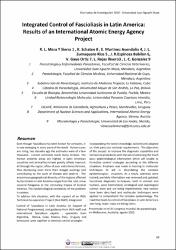Integrated control of Fascioliasis in Latin America: Results of an International Atomic Energy Agency Project
Date
2010-10Author
Mera y Sierra, Roberto
Schaten, K
Martinez Avendaño, E
Zumaquero Rios, J.L.
Espinoza Babilon, J.R.
Gayo Ortiz, V
Rojas Rivero, L
González, L.C.
Metadata
Show full item recordAbstract
Even though Fascioliasis has been known for centuries, it is now emerging in many parts of the world . Human cases are rising, two decades ago the estimates were of a few thousand , current estimates reach many millions. The human endemic areas are highest in Latin American countries and animal fascioliasis greatly affects livestock all through the region, often of poor subsistence farmers, thus decreasing even more their meager earnings and contributing to the cycle of disease and poverty . The enourmous geographical diversity of the regions affected by fascioliasis in Latin America ranges from the cold, snowcovered Patagonia to the simmering tropics of Central America. Fil: Mera y Sierra, Roberto. Universidad Juan Agustín Maza. Facultad de Ciencias Veterinarias y Ambientales. Parasitología y Enfermedades Parasitarias. Mendoza. República Argentina. Fil: Schaten, K. Department of Nuclear Sciences and Applications. International Atomic Energy Agency. Vienna. Austria. Fil: Martinez Avendaño, E. Universidad Mayor de San Andrés. Cátedra de Parasitología. La Paz. Bolivia. Fil: Zumaquero Rios, J.L. Escuela de Biologia. Benemérita Universidad Autónoma de Puebla. Puebla. México. Fil: Espinoza Babilon, J.R. Universidad Peruana Cayetano Heredia. Unidad Biotecnología Molecular. Lima. Perú. Fil: Gayo Ortiz, V. DILAVE, Ministerio de Ganadería, Agricultura y Pesca. Montevideo. Uruguay. Fil: Rojas Rivero, L. Instituto de Medicina Tropical. Subdirección de Parasitología. La Habana. Cuba. Fil: Gonzalez, L.C. Universidad de Los Andes. Microbiología y Parasitología. Mérida. Venezuela.











